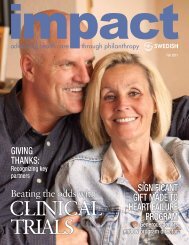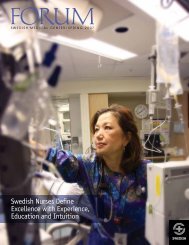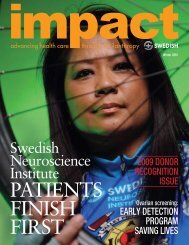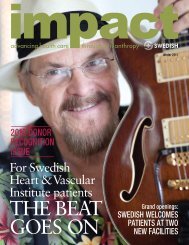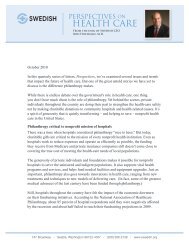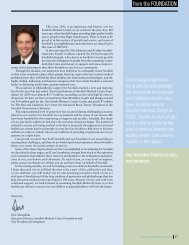PATIENTS FINISH FIRST - Swedish Medical Center Foundation
PATIENTS FINISH FIRST - Swedish Medical Center Foundation
PATIENTS FINISH FIRST - Swedish Medical Center Foundation
You also want an ePaper? Increase the reach of your titles
YUMPU automatically turns print PDFs into web optimized ePapers that Google loves.
FEATURE<br />
<strong>Swedish</strong><br />
MULTIPLE SCLEROSIS<br />
<strong>Center</strong><br />
M<br />
aria Coté received an un-<br />
welcome surprise around the<br />
time of her 40th birthday<br />
in 2001: After visiting her<br />
primary-care physician with<br />
what she thought might be<br />
two sprained ankles, which<br />
were giving her trouble walking,<br />
she was diagnosed with<br />
multiple sclerosis (MS), a<br />
chronic disease of the central<br />
nervous system that can cause<br />
disabling symptoms, including<br />
impaired vision, fatigue,<br />
muscle spasms and mental<br />
impairment.<br />
“When my primary-care<br />
doctor referred me to a neurologist,<br />
I was surprised,” remembers<br />
Coté. “I asked, ‘Isn’t<br />
a neurologist for the head?’ ”<br />
The neurologist she was<br />
referred to, Lily Jung, M.D.,<br />
of <strong>Swedish</strong>’s Multiple Sclerosis<br />
<strong>Center</strong>, concluded that Coté<br />
was suffering from MS after<br />
conducting numerous tests. “I<br />
didn’t want to give Maria that<br />
diagnosis,” says Jung. “She<br />
is such an energetic and passionate<br />
person, and it’s always difficult to<br />
give someone that kind of news.”<br />
“My first question after finding out<br />
was, ‘Is it fatal?’ ” recalls Coté. “I had no<br />
idea what this disease was. When I was<br />
diagnosed, my three kids started doing<br />
school reports on MS to help themselves<br />
learn about it. Now they are pros.”<br />
More than 400,000 people in the<br />
Maria Coté received a surprising diagnosis of multiple sclerosis in 2001. Despite<br />
the obstacles, Maria is healthy and active, refusing to let MS slow her down.<br />
United States are battling MS — a high<br />
percentage of whom live in the northern<br />
states (including Washington). Researchers<br />
aren’t sure what causes the disease, or why<br />
more of its sufferers hail from the northern<br />
latitudes. As a national leader in the<br />
care of patients with MS, the <strong>Swedish</strong><br />
Multiple Sclerosis <strong>Center</strong> is seeking<br />
answers, as well as more-effective treat-<br />
ments, through 16 ongoing<br />
research studies, while helping<br />
to make life more comfortable<br />
for patients living<br />
with MS through a host of<br />
support services.<br />
“If you’re going to be the<br />
best neurology institute, you<br />
need a strong MS center,”<br />
says former UW faculty member<br />
James Bowen, M.D., who<br />
has been medical director of<br />
the <strong>Swedish</strong> Multiple Sclerosis<br />
<strong>Center</strong> since 2008. Since his<br />
arrival at <strong>Swedish</strong>, Bowen<br />
and his team have seen significant<br />
growth in the number<br />
of patients receiving care<br />
there. “In 2008, we had 460<br />
returning patients and 235<br />
new patients. In 2009, we<br />
had 1,129 returning patients<br />
and 673 new patients,” says<br />
Bowen. He adds that the<br />
<strong>Center</strong> currently receives<br />
about 5,500 patient visits<br />
each year.<br />
One of the reasons for the<br />
increase in patients is the<br />
<strong>Swedish</strong> MS Wellness <strong>Center</strong>,<br />
which opened in March 2009 at <strong>Swedish</strong>’s<br />
Cherry Hill campus. The <strong>Center</strong> offers a<br />
full range of customized care and services,<br />
such as:<br />
– <strong>Medical</strong> treatments, including clinical<br />
trials, to alleviate symptoms<br />
– Nutrition consultations that teach<br />
patients how to eat for optimal health<br />
– Physical therapy, including assess-<br />
ment of each patient’s functional abilities<br />
and recommendation of an appropriate<br />
therapy program<br />
– Ongoing exercise classes, as well as<br />
a smoking-cessation program, to encourage<br />
health and physical fitness<br />
– Occupational therapy<br />
to support patients’<br />
efforts to remain in the<br />
workforce or to help<br />
smooth their transition<br />
out of it<br />
– Counseling to help<br />
patients and their families<br />
deal with depression,<br />
stress and emotional issues related<br />
to MS<br />
– Educational opportunities for patients<br />
and their families, including an<br />
MS Wellness Lecture Series and MS support<br />
group<br />
“Providing comprehensive care and<br />
services to patients is important,” says<br />
Bowen. “Being in good physical and<br />
mental shape can help patients weather<br />
future problems. I tell patients, if you’re<br />
physically fit and you have an attack<br />
that makes you weak, you could still<br />
be in reasonable shape. But if you’re a<br />
couch potato, you could end up in really<br />
bad shape.<br />
“MS is a very complicated disease<br />
and a difficult one to treat, because the<br />
distribution of symptoms is random and<br />
every patient is affected differently,”<br />
continues Bowen. “The disease has so<br />
many symptoms and challenges that patients<br />
are a moving target. It’s not like<br />
being in a car wreck, where if you have<br />
disabilities, it’s a one-time deal and you<br />
can adjust. With MS, people can continue<br />
to have attacks and get worse, and we<br />
have to adjust their therapy accordingly.”<br />
Maria began the nonprofit dog rescue FurKidz 911<br />
Connection with the help of her husband,<br />
Don. Shown here with volunteer Abde<br />
Elshafei (far left), the group has<br />
successfully found<br />
“forever” homes for<br />
many fortunate animals.<br />
Maria Coté is one of the <strong>Center</strong>’s<br />
success stories. After battling depression<br />
for two years following her diagnosis,<br />
she decided she wasn’t<br />
going to let MS control her<br />
life. Since the MS Wellness<br />
<strong>Center</strong> opened, she<br />
has taken advantage of<br />
many of its services, including<br />
a nutrition consultation,<br />
exercise classes and<br />
physical therapy, in addition to<br />
running the MS support group.<br />
“I can do things like exercise<br />
and eat well, but it helps to have<br />
guidance and motivation,” says<br />
Coté, who works part-time in<br />
IT for the City of Seattle and<br />
runs a nonprofit dog rescue,<br />
FurKidz 911 Connection.<br />
Lily Jung, M.D., of<br />
<strong>Swedish</strong>’s Multiple<br />
Sclerosis <strong>Center</strong>,<br />
reviews brain scans<br />
with a patient.<br />
Another source of motivation is the<br />
<strong>Swedish</strong> Smyelin Babes bike team. As an<br />
active member, Maria participates in the<br />
annual Bike MS Ride — a two-day<br />
tour through Skagit, Whatcom and<br />
Island counties sponsored by the Greater<br />
Northwest chapter of the National Multiple<br />
Sclerosis Society, during which cyclists<br />
ride courses ranging<br />
from 22 to 92 miles.<br />
(The 2010 ride will take<br />
place on September 11 and<br />
12.) Participants raise<br />
money to support MS<br />
research, programs and<br />
services. Jung started the<br />
<strong>Swedish</strong> team in 2005<br />
with a patient who liked to cycle and four<br />
other friends; by 2009’s race, the team had<br />
grown to 80 people, including Coté and 17<br />
other MS patients and many <strong>Swedish</strong> staff<br />
members. The team raised<br />
an impressive $80,000<br />
dollars for the National<br />
MS Society. “The ride<br />
is really awe inspiring,”<br />
says Jung.<br />
Jung adds: “Maria<br />
works despite the fact that<br />
she suffers from symptoms,<br />
including dizziness and vertigo,<br />
on top of being a mom.<br />
She gives her all to everything<br />
she’s involved in.<br />
Maria is an example of<br />
someone who has reached<br />
deep inside herself and<br />
figured out how to cope<br />
with this disease.”<br />
8 IMPACT WINTER 2010 www.swedishfoundation.org 9



